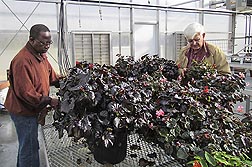|
Read the magazine story to find out more.
|
|
|
New Begonia Lines both Beautiful and Sturdy
By Jan Suszkiw
May 12, 2015
Two new begonia germplasm lines developed by U.S. Department of Agriculture (USDA) scientists and their collaborators are now available for use in breeding elite varieties of the ornamental crop that can tolerate the heat and humidity of a Gulf Coast summer.
Begonia semperflorens is the most widely cultivated type of begonia and fourth most popular bedding plant in the United States, generating $36 million in sales (in 2009). However, in Gulf Coast states like Mississippi, Georgia, Alabama and Florida, the onset of summer can overwhelm these popular flowering perennials with intense heat and humidity, cutting short the plants’ colorful presence in flowerbeds, hanging baskets and containers.
The new germplasm lines, labeled FB08-59 and FB08-163, were officially released in September 2014 as a source of genetic material that plant breeders can transfer better into commercial varieties for improved heat tolerance. Cecil Pounders, a retired plant geneticist with USDA’s Agricultural Research Service (ARS) in Poplarville, Mississippi, collaborated on the begonia releases with fellow ARS plant geneticist Hamidou Sakhanokho and colleague Leopold Nyochembeng of Alabama A&M University.
The team used a conventional plant-breeding technique called “recurrent selection” to develop the two germplasm lines. FB08-59 is the “top pick” of several generations of offspring plants that were evaluated after crosses between the commercial begonia Kaylen and B. cucullata var. arenosicola, an herbaceous South American species. FB08-163 was selected from a cross between Kaylen and the commercial begonia Shanzi.
FB08-59 and FB08-163 grow to heights of about 12 and 20 inches, respectively. Their dark, waxy leaves encircle purple-red flowers with white specks in the petals and yellow stamens in their centers.
In trials, Vodka, Whisky, Gin, Senator, Inferno Red, Bada Bing Red and Bada Boom Scarlet—varieties commonly planted in the South—fared poorly when grown under the same test conditions as FB08-59 and FB08-163, succumbing to a combination of heat stress and Pythium fungal infections, the team reported in the January 2015 issue of HortScience.
Read more about the begonia lines in the May 2015 issue of AgResearch magazine. ARS is USDA’s principal intramural scientific research agency.

